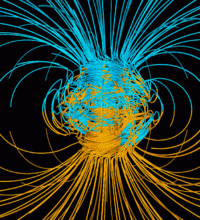
Photo from wikipedia
A one-dimensional implicit particle-in-cell/Monte Carlo collision model is used to study the effects of magnetic field gradients on the capacitively coupled argon plasma at 8 MHz and 40 MHz. The magnetic… Click to show full abstract
A one-dimensional implicit particle-in-cell/Monte Carlo collision model is used to study the effects of magnetic field gradients on the capacitively coupled argon plasma at 8 MHz and 40 MHz. The magnetic field strength at the powered electrode is fixed at 10 G, while varies from 30 to 100 G at the grounded electrode. The simulations show that the magnetic field with variable gradient can produce controllable asymmetry in the plasma density and ion flux profiles to each electrode. Increasing the magnetic field gradient will generate a significant dc self-bias, which results in a large ion bombardment energy at the powered electrode. The magnetic field gradients have been demonstrated to be an approach to create the dc self-bias and also effectively improve the plasma density. It is also found that at a higher frequency of 40 MHz, the dc self-bias voltage decreases, due to the fact that high collision rate of electrons with background gas will disturb the cyclotron motion of electrons, so the effect of the magnetic field is weakened. As a result, the ability to independently control ion energy and flux is weakened.
Journal Title: Plasma Sources Science and Technology
Year Published: 2023
Link to full text (if available)
Share on Social Media: Sign Up to like & get
recommendations!